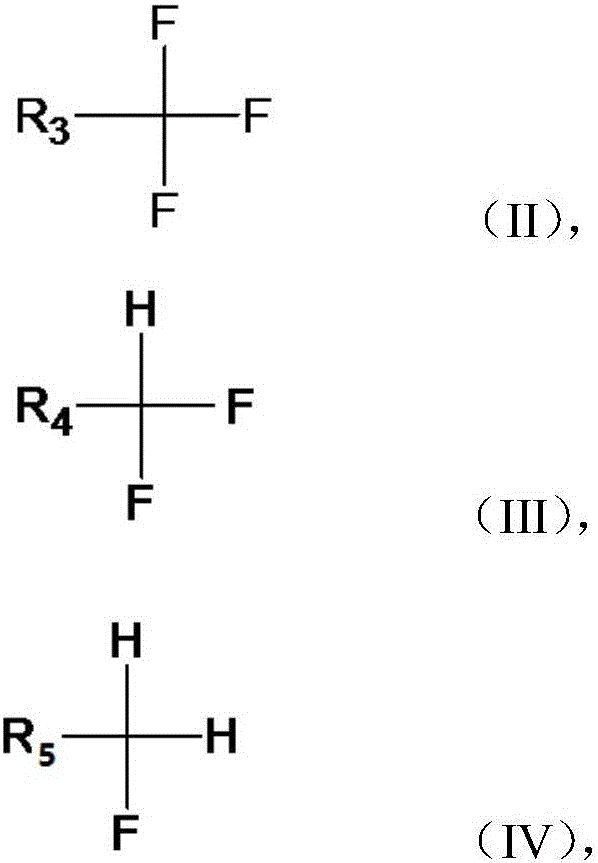Electrolyte and lithium ion battery with same
An electrolyte and lithium salt technology, applied in secondary batteries, secondary battery repair/maintenance, circuits, etc., can solve the problem of improving the oxidation of the positive electrode, so as to improve oxidation resistance, improve storage and cycle performance, and prevent dissolution Effect
- Summary
- Abstract
- Description
- Claims
- Application Information
AI Technical Summary
Problems solved by technology
Method used
Image
Examples
Embodiment 1
[0025] (1) Preparation of electrolyte
[0026] According to each material shown in Table 1 and its addition amount, numbering is carried out multiple groups of tests, get different quality fluorocarbonate, cyclohexanetrinitrile, adiponitrile, fluoroethylene carbonate, vinylene carbonate, Propane sultone and lithium salt were dissolved in an organic solvent and mixed uniformly to obtain multiple sets of electrolytes. The amount added in Table 1 refers to the mass fraction of each material in the total mass of the electrolyte. Wherein, the structural formula of the fluorocarbonate is Among them, R 1 , R 2 Respectively terminal fluorine-containing alkyl groups, the organic solvent is ethylene carbonate, ethylene carbonate, dimethyl carbonate, diethyl carbonate, ethyl methyl carbonate, r-butyrolactone, methyl formate, ethyl formate one or more of them. The lithium salt is lithium hexafluorophosphate, lithium tetrafluoroborate, lithium hexafluoroarsenate, lithium perchlorate, ...
Embodiment 2
[0048] Get ethylene carbonate: diethyl carbonate: ethyl methyl carbonate volume ratio is the mixed solvent of 1:1:1 as organic solvent, adds lithium salt wherein, described lithium salt is lithium hexafluorophosphate, and concentration is 1.1mol / L, obtains Electrolyte mother liquor. According to each material and its addition amount shown in Table 5, each material was added to the electrolyte mother liquor, the addition amount in the table is the mass fraction of each material in the total electrolyte mass, and the electrolyte samples 1-6 were obtained.
[0049] Table 5 each material and its addition amount
[0050]
[0051]
[0052] Take the uninjected battery cell, inject electrolyte samples 1-6 respectively, and then fully charge the finished battery cell to 4.5V with 0.5C constant current and constant voltage, and the current cut-off is 0.02C, put the battery cell in the glove Dismantling in the box, the moisture and oxygen content in the glove box are both ≤10ppm, ...
Embodiment 3
[0057] Dissolve fluorocarbonate, cyclohexanetrinitrile, adiponitrile, fluoroethylene carbonate, vinylene carbonate, propane sultone and lithium salt in an organic solvent and mix them uniformly to obtain an electrolyte solution, wherein the The structural formula of the fluorocarbonate is Among them, R 1 for R 2 for The quality of the fluorocarbonate accounts for 0.1% of the total mass of the electrolyte, the quality of cyclohexanetrinitrile accounts for 10% of the total mass of the electrolyte, the quality of fluoroethylene carbonate accounts for 0.1% of the total mass of the electrolyte, and the mass of ethylene carbonate accounts for 0.1% of the total mass of the electrolyte. The mass of vinyl ester accounts for 3% of the total mass of the electrolyte, and the mass of propane sultone accounts for 0.1% of the total mass of the electrolyte. The organic solvent is a mixed solvent of ethylene carbonate: diethyl carbonate: ethyl methyl carbonate with a volume ratio of 1:1...
PUM
 Login to View More
Login to View More Abstract
Description
Claims
Application Information
 Login to View More
Login to View More - R&D
- Intellectual Property
- Life Sciences
- Materials
- Tech Scout
- Unparalleled Data Quality
- Higher Quality Content
- 60% Fewer Hallucinations
Browse by: Latest US Patents, China's latest patents, Technical Efficacy Thesaurus, Application Domain, Technology Topic, Popular Technical Reports.
© 2025 PatSnap. All rights reserved.Legal|Privacy policy|Modern Slavery Act Transparency Statement|Sitemap|About US| Contact US: help@patsnap.com



